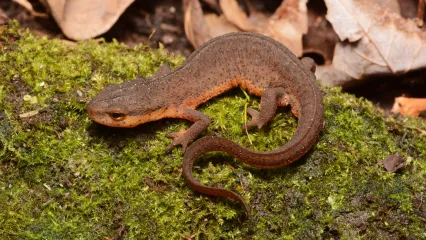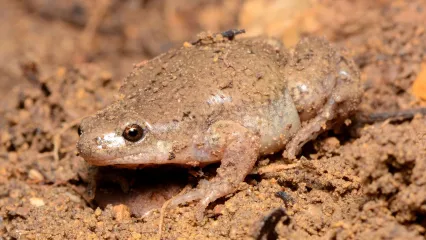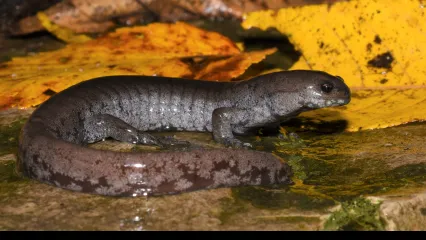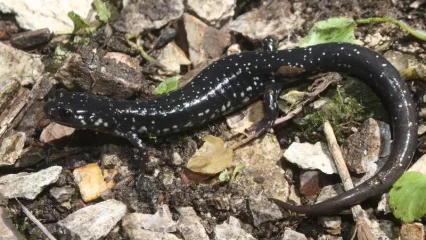
Description
Central newts are moderately small salamanders with rough skin, no external gills in adults, and no costal grooves on the abdomen. They are unusual among Oklahoma salamanders and salamanders in general in that they have an aquatic larval stage, a terrestrial “eft” stage, and an aquatic adult stage.
Body color of adults varies from brown to green to yellowish, with numerous small black dots on the body and tail. The tail of larvae and aquatic adults has a high tail fin both above and below the vertebrae. The belly of aquatic adults is yellow or orange-yellow and also contains black dots, but not as many as on the dorsal surface. The eyes are yellow with a dark horizontal bar through the center. The eft stage, also called the red eft, is red to reddish-brown dorsally with small red wart-like protrusions from the rough skin. The tail of the eft stage is only slightly compressed laterally and has no fin. Efts have dry skin.
Size
Central newts can reach up to 5 inches in total length, but most adults vary in size from 2.5 to 4 inches.
Habitat
Central newts occur throughout the eastern one-third of Oklahoma, but their distribution in this part of the state is spotty. Most undisturbed ponds within forests of the Ozark foothills and the Ouachita Mountains contain central newts, and some farm ponds in open fields also contain populations. They extend west of the Ozark foothills and the Ouachita Mountains in forested areas. Central newts are part of a species complex of eastern newts that extends west to east from eastern Oklahoma across the entire eastern United States and north to south from Canada through all of Peninsular Florida.
Life Cycle
The natural history of central newts is complex and varies from one locality to another. Similar to most other salamanders, central newts have an egg and an aquatic larval stage. Courtship takes place in late winter and early spring. Following courtship behavior, the male deposits a spermatophore on the bottom of the pond. The spermatophore is a stalk-like structure with a packet of sperm on the top. The female then positions her body over the spermatophore and picks up the packet of sperm with her cloaca. Unlike frogs, fertilization is internal.
Female newts deposit as many as 400 small eggs on submerged vegetation, usually in late spring or early summer. Eggs hatch in three to five weeks and the gilled larvae remain in ponds through summer. In late summer, larvae lose their gills and emerge from the water as efts. They remain as terrestrial efts for several years before they reach adult size and return to ponds. When they reenter ponds, they lose the red coloration and develop fins on their tails, and the life cycle starts over.
Larvae of central newts feed on a variety of tiny aquatic arthropods, including newly hatched aquatic insect larvae. Adults feed on larger aquatic invertebrates, including insects, crawfish, snails and earthworms.
How To Observe
Central newts are relatively easy to observe by turning rocks and logs on the forest floor or by using a dip net in ponds. Because central newts have noxious chemicals in their skin, it is a good idea to thoroughly wash hands after handling.
(This profile was created by Dr. Laurie Vitt as part of a partnership between the Wildlife Department and the Sam Noble Oklahoma Museum of Natural History. It was funded as part of a larger State Wildlife Grant to survey and inventory amphibians and reptiles of the Wildlife Management Areas of Oklahoma: T-35-P-1.)


